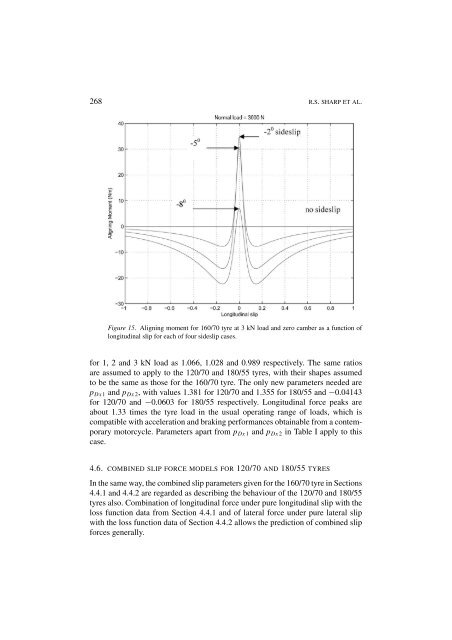Advances in the Modelling of Motorcycle Dynamics - ResearchGate
Advances in the Modelling of Motorcycle Dynamics - ResearchGate
Advances in the Modelling of Motorcycle Dynamics - ResearchGate
Create successful ePaper yourself
Turn your PDF publications into a flip-book with our unique Google optimized e-Paper software.
268 R.S. SHARP ET AL.Figure 15. Align<strong>in</strong>g moment for 160/70 tyre at 3 kN load and zero camber as a function <strong>of</strong>longitud<strong>in</strong>al slip for each <strong>of</strong> four sideslip cases.for 1, 2 and 3 kN load as 1.066, 1.028 and 0.989 respectively. The same ratiosare assumed to apply to <strong>the</strong> 120/70 and 180/55 tyres, with <strong>the</strong>ir shapes assumedto be <strong>the</strong> same as those for <strong>the</strong> 160/70 tyre. The only new parameters needed arep Dx1 and p Dx2 , with values 1.381 for 120/70 and 1.355 for 180/55 and −0.04143for 120/70 and −0.0603 for 180/55 respectively. Longitud<strong>in</strong>al force peaks areabout 1.33 times <strong>the</strong> tyre load <strong>in</strong> <strong>the</strong> usual operat<strong>in</strong>g range <strong>of</strong> loads, which iscompatible with acceleration and brak<strong>in</strong>g performances obta<strong>in</strong>able from a contemporarymotorcycle. Parameters apart from p Dx1 and p Dx2 <strong>in</strong> Table I apply to thiscase.4.6. COMBINED SLIP FORCE MODELS FOR 120/70 AND 180/55 TYRESIn <strong>the</strong> same way, <strong>the</strong> comb<strong>in</strong>ed slip parameters given for <strong>the</strong> 160/70 tyre <strong>in</strong> Sections4.4.1 and 4.4.2 are regarded as describ<strong>in</strong>g <strong>the</strong> behaviour <strong>of</strong> <strong>the</strong> 120/70 and 180/55tyres also. Comb<strong>in</strong>ation <strong>of</strong> longitud<strong>in</strong>al force under pure longitud<strong>in</strong>al slip with <strong>the</strong>loss function data from Section 4.4.1 and <strong>of</strong> lateral force under pure lateral slipwith <strong>the</strong> loss function data <strong>of</strong> Section 4.4.2 allows <strong>the</strong> prediction <strong>of</strong> comb<strong>in</strong>ed slipforces generally.
















